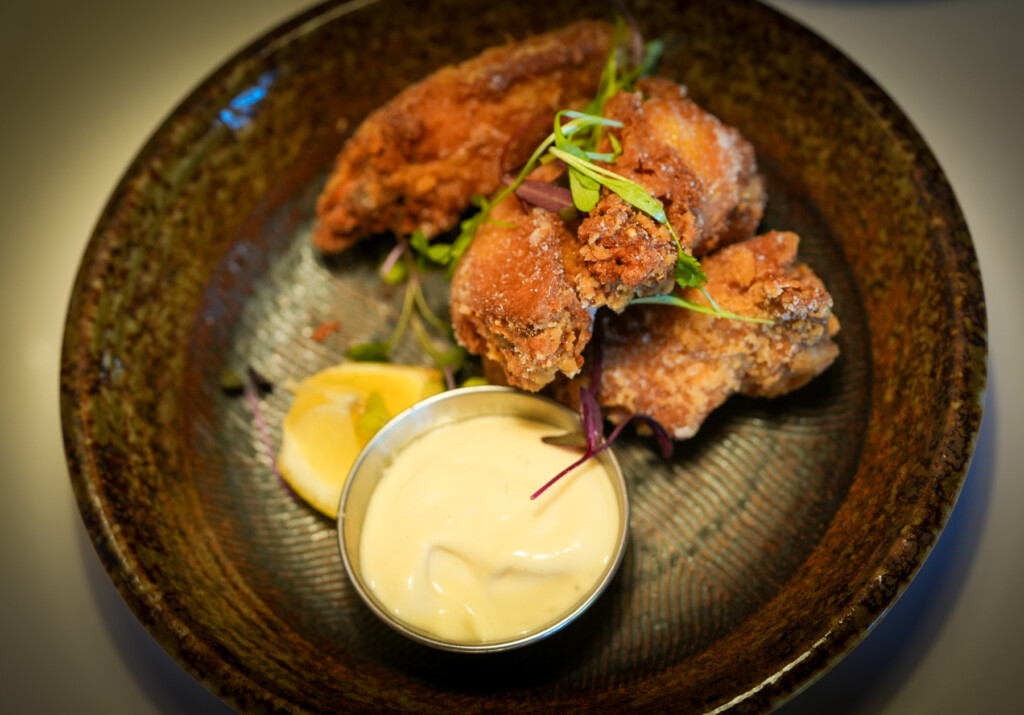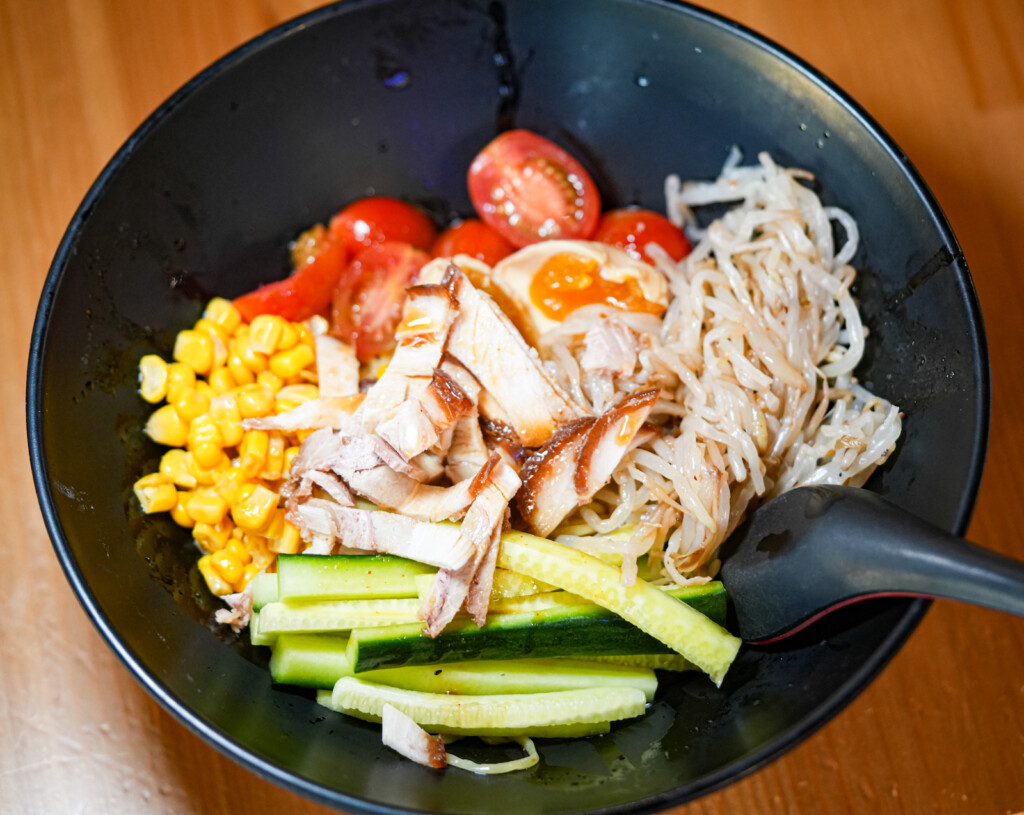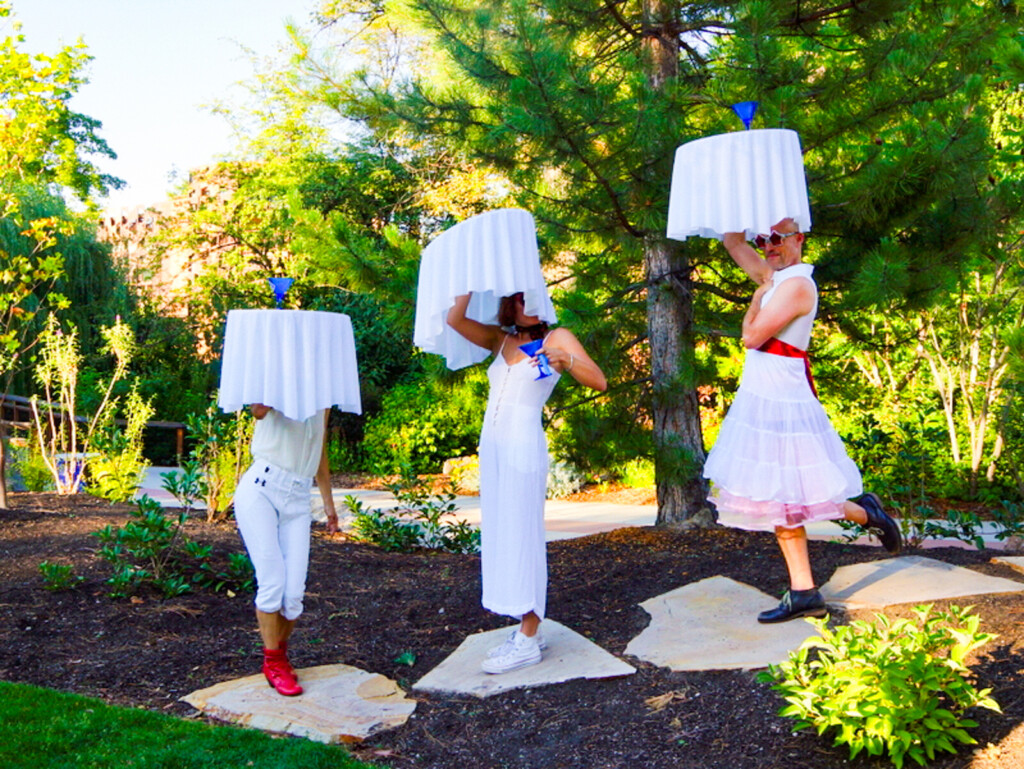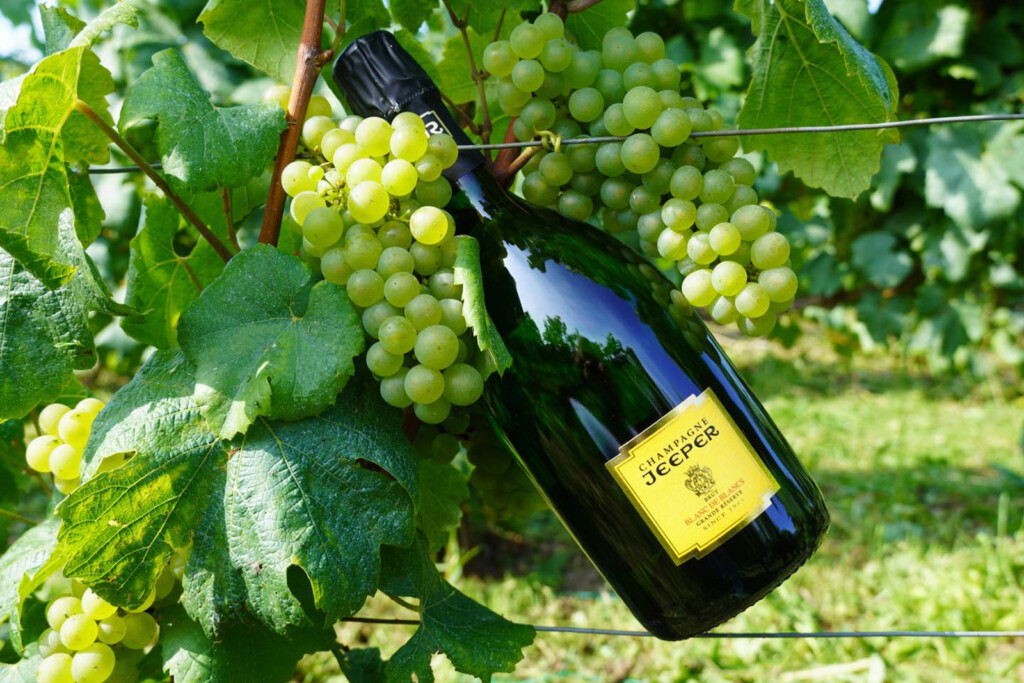Located in the Marmalade neighborhood, Koyoté is the creation of Chef/Owner Hiro Tagai, who worked for about a decade as head sushi chef at Happy Sumo before moving back to his home country of Japan to study at ramen school (yes, there is such a thing) and to work in ramen shops. After returning to the U.S. he helped open Purgatory with the Sapa Restaurant Group and also worked at Briar Handly’s HSL. Personally, I love what he’s done with the industrial space on 400 North which was formerly home to offices. The design is sleek and contemporary, but with a very warm and inviting vibe.
There is lots of wood and warm colors throughout the restaurant, with orange and yellow hues and splashes of red. In addition to tables and small booths, there is a long counter that gives guests a glimpse into the busy kitchen and seats what looks to be a dozen or so customers.
Tagai has said that he has an interest in izakaya-style eateries which, in Japan, are primarily bars that serve bar food such as yakitori, ramen and such. Koyoté isn’t a bar per se – although they do serve wine, beer and sake – but the abbreviated menu is much in the izakaya mode with a dozen or so small plate and appetizer size dishes, seven ramen options, side dishes, and desserts. There are no entrees, per se. I really like izakaya since it allows one to enjoy a number of smaller dishes rather than, say, a big steak or piece of fish with composed sides. Sometimes, less is more.
Before we delve into the food, a word about service and the ordering process at Koyoté, which is fairly unique. As has been the case with many restaurants since the pandemic, menus are accessed via QR codes on each table. That’s pretty standard these days. What isn’t so standard is that there are no servers at Koyoté to take your order or walk you through the menu. Customers order and pay for their meals via their smartphones and the food and drink is brought to guests by young food runners. This style of DoorDash type dining isn’t for everyone. For example, we ordered five dishes and they pretty much all arrived at our small table simultaneously. Lesson learned: At Koyoté you’ll want to keep your tab open and order dishes incrementally to space out your meal.
The Koyoté menu lists two wines by the glass: red and white. We were never able to find out from the food runners what varieties the wines were, nor who produced the wines; there was somewhat of a language barrier. So we ordered beer. Corkage is $15 if you’d prefer to provide your own wine.
Shioyaki Saba
A great fish dish at Koyoté is Shioyaki Saba ($12), which is a whole mackerel, steamed and then broiled and seasoned with grated ponzu daikon called daikon oroshi, topped with scallions and mizuna with and a lemon wedge served on the side. The mackerel was crispy and delicious. Another fish option is Sake-don ($15) – fresh salmon that is lightly seared and sliced, served with Japanese rice and topped with Japanese pickled plum called ume and shiso paste.
Karaage Chicken Wings
Karaage is a Japanese cooking method wherein foods – often chicken – are deep-fried in oil. At Koyoté, you’ll find Karaage Chicken Wings ($9) on the menu: wings that are brined first then coated with Japanese potato starch (which is gluten free), double fried in oil, topped with mizuna and dusted with vinegar and salt – a tad too much salt for my taste – but nice and crisp on the outside and moist and delicious inside. Other appetizers include Pickled Veggies ($3), Lotus Chips ($3), Plant-Based Gyoza ($7), House Gyoza ($6), Atsu Kimchi ($5), and Daikon “Steak” ($7).
Mapo Tofu
For meat eaters, Koyoté has Chashu-don ($9), which is tender braised pork drizzled with sweet soy sauce, garnished with scallions and sesame seeds, and served on a bed of Japanese rice. By the way, the premium Japanese rice served at Koyoté is superb. There is also Traeger smoked Brisket-don ($11) – slow-smoked brisket with sweet soy and rice. Unfortunately, the kitchen had run out of brisket on our visit. The menu describes the Mapo Tofu ($9) as “not as spicy” as traditional Chinese style mapo tofu, but I beg to differ. My lips were burning after enjoying the creamy, soft blanched tofu bathed in a chili oil broth with ground pork and topped with mizuna. That perfect Japanese rice is served alongside the fiery but fantastic mapo tofu.
The Classic Ramen
There are seven different ramen options at Koyoté, including a brothless ramen called Koyoté Mazamen ($16); Gluten Free Shoyu Ramen ($16) made with gluten free shoyu tare and gluten free noodles; a vegetarian ramen called Tantan-men ($15); Vegan Ramen ($14); Tonkotsu Tsukemen dipping ramen ($14); and Tokyo-style American Shoyu ($17) with smoked brisket. If The Classic ramen ($16) I ordered is any indication, Hiro Tagai’s stint in Japanese ramen school really paid off. It is, quite simply, the best ramen I’ve eaten in Utah. The Classic ramen begins with a clear, scrumptious chicken and pork stock that I’m told simmers for some 10 hours, to which are added perfectly cooked chuuka soba noodles, umami-packed soft-boiled Japanese-style ajitama eggs marinated in sweetened soy, large slices of tender chashu pork, naga negi (Japanese green onions), blanched spinach, scallions, and menma – tender lacto-fermented bamboo shoots. This is some seriously rad ramen!
For kids, there’s a pint-sized okosama ramen ($7) and add-ons or sides include chili crisp ($2.50), extra kaedama noodles ($2), ajitama ($3), rice ($2.50), and something called a mayuku bomb ($2), which is – according to the menu – a “gluten free spicy ball of explosion.” It’s a spice paste made from eight different spices and chilies, recommended as a condiment for tsukemen and tantan-men.
For dessert, there is Purin ($5), which is Japanese-style smooth custard with an Asian black sugar caramel drizzle, as well as Kuromitsu Ice Cream ($5) – vanilla ice cream infused with Japanese kuromitsu syrup and topped with roasted soybean flour called kinako.
There is a lot to love about Hiro Tagai’s Koyoté restaurant and it’s a terrific addition to the SLC dining scene delivering an abundance of Asian fare with flair. Personally, I can’t wait to return to try some of the other ramens and that smoked brisket. In the words of Arnold Schwarzenegger, “I’ll be back!”
Photos by Ted Scheffler
Culinary quote of the week: “The last time I was surprised was when I found out that ice cream cones were hollow.” Pete Maravich






